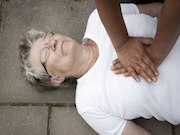Bystander defibrillation increases odds of survival to hospital discharge, with favorable functional outcome
THURSDAY, March 1, 2018 (HealthDay News) — Bystander automated external defibrillator use in shockable observed public out-of-hospital cardiac arrest (OHCA) is associated with improved survival and functional outcomes, according to a study published online Feb. 26 in Circulation.
Ross A. Pollack, from the Johns Hopkins University School of Medicine in Baltimore, and colleagues collected detailed information on all cardiac arrests at nine regional centers to examine the correlation of bystander automated external defibrillator use with survival and functional outcomes. The correlation was examined in shockable observed OHCA.
The researchers found that 4,115 observed public OHCAs were analyzed, out of 49,555 OHCAs; 60.8 percent of the observed public OHCAs were shockable. In 18.8 percent of the shockable arrests, a bystander shock was applied. Compared with patients initially shocked by emergency medical services, patients who were shocked by a bystander were significantly more likely to survival to discharge (66.5 versus 43.0 percent) and to be discharged with favorable functional outcome (57.1 versus 32.7 percent). Bystander shock correlated with odds ratios of 2.62 and 2.73 for survival to hospital discharge and discharge with favorable functional outcome, respectively, after adjustment for known predictors of outcome. As emergency medical services response time became longer, the benefit of bystander shock increased progressively.
“Continued emphasis on public automated external defibrillator utilization programs may further improve outcomes of OHCA,” the authors write.
One author disclosed financial ties to HeartSine.
Copyright © 2018 HealthDay. All rights reserved.








